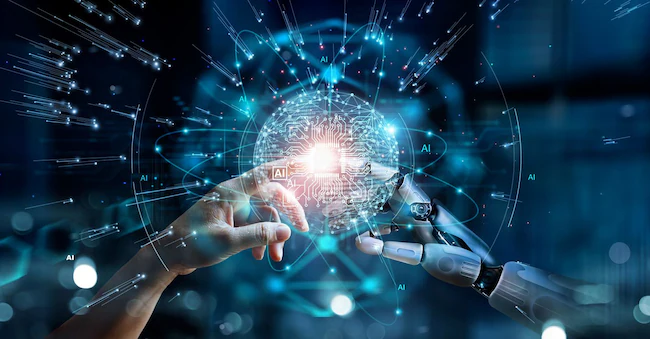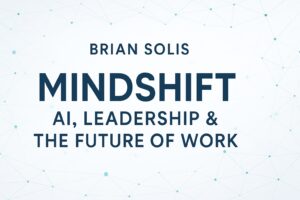
AI is not just automation, but potential to expand human capabilities and redefine leadership models; an interview with Brian Solis
Is artificial intelligence synonymous with automation? Absolutely yes, but not only. This is because the transformative powers of algorithms and generative technologies are indeed changing our lives (private and work) and the way we make decisions, but too often the business debate on the impacts of these technologies focuses solely on the automation component of processes. Instead, there is more, much more. According to Brian Solis, futurologist and Head of Global Innovation ServiceNow, the true potential of artificial intelligence lies in three complementary ‘functions’: expanding human capabilities, redefining leadership models and generating profound social and cultural impact. In his vision, artificial intelligence is therefore not just a tool for ‘doing the same things better’ but a catalyst for rethinking the models through which value is created, relationships are built and the future of organisations is imagined. The concept of ‘human-centred innovation’ is not by chance a recurring theme in Solis’ thinking, because – in his words – ‘it is not about replacing man, but making him the protagonist of a new era’. Here is what he exclusively told Sole24Ore.com during his recent participation in AI Week in Milan.
In the debate on the adoption of AI, you point out a fundamental misunderstanding: companies mistake the amplification of human capabilities for simple automation. Why is this misunderstanding so widespread?
Among the most common use cases of AI are automating repetitive tasks and workflows, enhancing self-service operations and reducing operational costs. This is certainly where the journey with AI should start, identifying immediate use cases, demonstrating results quickly and generating ROI. But when we limit our investments to automation and savings, we risk creating a new era of AI-enhanced ‘status quo’. An automation-centric approach is normal, it is the way most organisations have approached cycles of technological innovation since the industrial revolution: increase efficiency, contain costs, increase productivity and profits. And AI does all of this and more, because it is a revolution capable of growing the next generation of businesses in ways yet unimaginable. And that is exactly the point: we are at a decisive moment, some companies will stop at automation, maximising profits, but the most forward-thinking managers can change the narrative of this revolution.
What risks does this ‘ambiguity’ entail from a business perspective?
In addition to scaling efficiency, artificial intelligence can also redefine workflows to stimulate growth. For those who see AI only as an automation tool, it ends up becoming, perhaps unwittingly, a mere enabler, only more modern, of ‘business as usual’. This approach consolidates the operational models of the past, with the aim of optimisation, but it carries risks: standing still while others reinvent workflows and amplify human capabilities can in fact stall growth. Instead, for those willing to rethink work and look for new ways to enhance it, a new chapter of business transformation opens up, leading to the creation of a company that not only optimises proven models, but also aims for new and previously unattainable results without artificial intelligence. The result goes beyond linear growth, triggering exponential development cycles and challenging those stuck in the past.
How can companies shift their focus from operational efficiency to transformative value creation through AI?
Before talking about the ‘how’, we need to better understand the ‘why’.
Performance optimised by automation and results enhanced and augmented by AI are two different approaches: one is based on iteration, the other on innovation. Iteration gradually improves work and makes what was done yesterday more efficient, cheaper and more scalable today. Innovation, on the other hand, generates entirely new value, with results, processes and products that were previously unthinkable or impossible to achieve without artificial intelligence. In a nutshell, it can be said that automation scales the past while augmentation builds the future. It is a change of mindset, a profound change of perspective that breaks the mould and opens up new possibilities and anticipates the future with AI. The differences are crucial because they reflect not only performance, but also trajectory: incremental growth measures savings, margins and productivity gains, and all these benefits are reinvested in the organisation.
Are there any models or virtuous cases that point in the right direction?
Exponential leaders know that the key question is: ‘what can we do with the resources and time freed up by AI’? From here on, the direction depends on the mindset. If the time and resources saved lead to scrutinising roles for redundancies, jobs are likely to disappear. If, on the other hand, the measure of value includes productivity and the creation of new value, jobs become catalysts of increased potential.
Instead of asking what roles to cut, in other words, one must ask how artificial intelligence can enhance human potential. This is how we define the jobs of the future in the AI economy.
Many managers struggle to find their way in a rapidly changing environment. What kind of leadership is needed to guide people in a hybrid future, where technology and humanity must coexist harmoniously?
This is the inspirational thinking behind my book ‘Mindshift: Transform Leadership, Drive Innovation, and Reshape the Future’. If you wait for someone to tell you what to do in this AI era, you put yourself on the wrong side of innovation, but there is still no manual to follow. We definitely need a new breed of leaders and these new leaders can spring up anywhere. We need to feel empowered to explore the unknown, question conventions and ask more questions that start with “why?”, “what if?”, “how could we…?”. Historically, the role of the manager has been to ensure standards and results based on established models, but such an approach relegates something as revolutionary as artificial intelligence to the level of mere iteration. It has always been their job, and no one has ever told managers to do anything different. Roles have not been rethought, but I can guarantee that managers are asking questions that challenge their ‘comfort zone’: what should I do? What should I learn? And many of them feel anxiety, uncertainty and fear because of the lack of vision.
While exponential leaders do not suffer from these problems…
Exponential leaders define a new vision, new goals and new standards. They inspire a culture that can generate the work that changes the trajectory of the organisation and they are called upon to challenge other leaders to amplify this vision to create a culture of innovation and transformation in synergy with the spread of artificial intelligence. Failing this, it is the managers who will have to ignite the spark of transformation. Any vision or insight can inspire any level of leadership.
Last question: if you had to send a message to Italian companies, what would be the first concrete step to take in order not to remain on the sidelines of this revolution?
I love this question, thank you for asking it. A cautious and thoughtful approach to AI adoption is understandable because we are human and uncertainty is part of the game. However, if ‘caution’ becomes fear, ignorance or arrogance, the pace of innovation can quickly drive us out of business.
The truth is that dealing with and managing change is difficult. And when you are faced with concepts like generative artificial intelligence, AI agents, AGI (Artificial General Intelligence, ed) or quantum, it is natural to feel overwhelmed. But to stand by and watch is to do nothing, and I am convinced that the first concrete step is to stop looking for excuses. After several years working with startups, I can tell you one thing I have never heard from a founder: ‘it can’t be done because…’. Bold leaders always find a way to act.
Any practical advice for leaders who want to take action?
Form a dedicated consulting team, assess the context and timeframe for technology adoption, compare these projections with available skills, investments and capabilities, and finally identify one or more concrete pilot projects where AI can generate measurable value in a matter of weeks, not months or years. The goal is not perfection, but learning and progress, so it is crucial to understand where your organisation stands with respect to the current and future impacts of AI: this will be the basis for a strategy based on a willingness to experiment. AI will not replace leaders, but it will make leaders who refuse to lead obsolete.
🇮🇹
Leadership e AI: ripensare modelli e strategie aziendali
L’AI non è solo automazione, ma potenzialità di espandere capacità umane e ridefinire modelli di leadership
Intelligenza artificiale è sinonimo di automazione? Assolutamente sì, ma non solo. E questo perché le doti trasformative degli algoritmi e delle tecnologie generative stanno effettivamente cambiando la nostra vita (privata e lavorativa) e il modo di prendere decisioni, ma troppo spesso il dibattito aziendale sugli impatti di queste tecnologie va a focalizzarsi unicamente sulla componente di automazione dei processi. E invece c’è altro, molto altro. Secondo Brian Solis, futurologo e Head of Global Innovation ServiceNow, il vero potenziale dell’intelligenza artificiale risiede in tre “funzioni” fra loro complementari: espandere le capacità umane, ridefinire i modelli di leadership e generare un impatto sociale e culturale profondo. Nella sua visione, l’intelligenza artificiale non è quindi solo uno strumento per “fare meglio le stesse cose” ma un catalizzatore per ripensare i modelli attraverso i quali si crea valore, si costruiscono relazioni e si immagina il futuro delle organizzazioni. Il concetto di “human-centered innovation” è non a caso un tema ricorrente nel pensiero di Solis, perché – sue parole – “non si tratta di sostituire l’uomo, ma di renderlo protagonista di una nuova era”. Ecco cosa ha raccontato in esclusiva al Sole24Ore.com in occasione della sua recente partecipazione all’AI Week di Milano.
Nel dibattito sull’adozione dell’AI, lei sottolinea un equivoco di fondo: le imprese scambiano l’amplificazione delle capacità umane con la semplice automazione. Perché questo fraintendimento è così diffuso?
Tra i casi d’uso più comuni dell’AI ci sono l’automazione di compiti ripetitivi e flussi di lavoro, il rafforzamento delle operazioni self-service e la riduzione dei costi operativi. È sicuramente da qui che dovrebbe iniziare il percorso con l’intelligenza artificiale, individuando use case immediati, dimostrando risultati in tempi rapidi e generando ROI. Ma quando limitiamo i nostri investimenti all’automazione e al saving, rischiamo di creare una nuova era di “status quo” potenziato dall’AI. Un approccio centrato sull’automazione è normale, è il modo in cui la maggior parte delle organizzazioni ha affrontato i cicli delle innovazioni tecnologiche fin dai tempi della rivoluzione industriale: aumentare l’efficienza, contenere i costi, incrementare la produttività e i profitti. E l’AI fa tutto questo e anche di più, perché è una rivoluzione capace di far crescere la prossima generazione di imprese in modi ancora inimmaginabili. Ed è proprio questo il punto: siamo in un momento decisivo, alcune aziende si fermeranno all’automazione, massimizzando i profitti, ma i manager più lungimiranti possono cambiare la narrazione di questa rivoluzione.
Quali rischi comporta, questa “ambiguità”, in chiave business?
L’intelligenza artificiale, oltre a scalare l’efficienza, può anche ridefinire i flussi di lavoro per stimolare la crescita. Per chi vede l’AI solo come uno strumento di automazione, essa finisce per diventare, forse inconsapevolmente, un mero abilitatore, solo più moderno, del “business as usual”. Questo approccio consolida i modelli operativi del passato, con l’obiettivo di ottimizzare, ma comporta dei rischi: restare fermi mentre altri reinventano i flussi di lavoro e amplificano le capacità umane può infatti bloccare la crescita. Per chi è disposto a ripensare il lavoro e cercare nuovi modi di potenziarlo, si apre invece un nuovo capitolo della trasformazione aziendale, che porta alla creazione di un’azienda che non solo ottimizza modelli collaudati, ma punta anche a risultati nuovi e precedentemente irraggiungibili senza l’intelligenza artificiale. Il risultato va oltre la crescita lineare, innescando cicli di sviluppo esponenziali e mettendo in crisi chi resta ancorato al passato.
In che modo le aziende possono spostare l’attenzione dall’efficienza operativa alla creazione di valore trasformativo grazie all’AI?
Prima di parlare del “come”, dobbiamo comprendere meglio il “perché”.
La performance ottimizzata tramite automazione e i risultati potenziati e aumentati dall’AI sono due approcci diversi: uno si basa sull’iterazione, l’altro sull’innovazione. L’iterazione migliora gradualmente il lavoro e rende oggi più efficiente, meno costoso e più scalabile ciò che si faceva ieri. L’innovazione, invece, genera un valore del tutto nuovo, con risultati, processi e prodotti prima impensabili o impossibili da raggiungere senza l’intelligenza artificiale. In estrema sintesi si può affermare che l’automazione scala il passato mentre la cosiddetta “augmentation” costruisce il futuro. È un cambiamento di mentalità, un cambio profondo di prospettiva che spezza gli schemi e apre nuove possibilità e che anticipa il futuro con l’AI. Le differenze sono cruciali perché non riflettono solo la performance, ma anche la traiettoria: la crescita incrementale misura risparmi, margini e aumento della produttività, e tutti questi benefici vengono reinvestiti nell’organizzazione.
Ci sono modelli o casi virtuosi che indicano la giusta direzione?
I leader esponenziali sanno che la domanda chiave è la seguente: “cosa possiamo fare con le risorse e il tempo liberati dall’AI”? Da qui in avanti, la direzione dipende dalla mentalità. Se il tempo e le risorse risparmiate portano a scrutinare i ruoli per valutare ridondanze, i posti di lavoro rischiano di sparire. Se invece la misura del valore include produttività e creazione di nuovo valore, i posti di lavoro diventano catalizzatori di potenziale aumentato.
Invece di chiedersi quali ruoli tagliare, in altre parole, ci si deve chiedere come l’intelligenza artificiale possa aumentare il potenziale umano. È così che si definiscono i lavori del futuro nell’economia dell’AI.
Molti manager faticano a orientarsi in un contesto in rapido mutamento. Che tipo di leadership è necessaria per guidare le persone in un futuro ibrido, dove tecnologia e umanità devono coesistere armonicamente?
Questa è la riflessione ispirazionale alla base del mio libro “Mindshift: Transform Leadership, Drive Innovation, and Reshape the Future”. Se si aspetta che qualcuno ti dica cosa fare in questa era dell’AI, ci si mette dalla parte sbagliata dell’innovazione, ma non esiste ancora un manuale da seguire. Abbiamo sicuramente bisogno di una nuova categoria di leader e questi nuovi leader possono nascere ovunque. Dobbiamo sentirci autorizzati ad esplorare l’ignoto, mettere in discussione le convenzioni e porci più domande che iniziano con “perché?”, “e se?”, “come potremmo…?”. Storicamente, il ruolo del manager è stato quello di garantire standard e risultati basati su modelli consolidati, ma tale approccio relega qualcosa di rivoluzionario come l’intelligenza artificiale al livello di semplice iterazione. È sempre stato il loro lavoro, e nessuno ha mai detto ai manager di fare qualcosa di diverso. I ruoli non sono stati ripensati ma posso garantire che i manager si stanno ponendo domande che mettono in dubbio la loro “comfort zone”: cosa devo fare? Cosa devo imparare? E molti di loro provano ansia, incertezza e timore per la mancanza di visione.
Mentre i leader esponenziali non soffrono di questi problemi…
I leader esponenziali definiscono una nuova visione, nuovi obiettivi e nuovi standard. Ispirano una cultura in grado di generare il lavoro che cambia la traiettoria dell’organizzazione e sono chiamati a sfidare gli altri leader ad amplificare questa visione per creare una cultura di innovazione e trasformazione in sinergia con la diffusione dell’intelligenza artificiale. In mancanza di questo, saranno proprio i manager a dover accendere la scintilla della trasformazione. Qualsiasi visione o intuizione può ispirare ogni livello di leadership.
Ultima domanda: se dovesse lanciare un messaggio alle imprese italiane, quale sarebbe il primo passo concreto da compiere per non restare ai margini di questa rivoluzione?
Adoro questa domanda, grazie per averla posta. Un approccio cauto e riflessivo nell’adozione dell’AI è comprensibile perché siamo umani e l’incertezza fa parte del gioco. Se però la “cautela” diventa paura, ignoranza o arroganza, il ritmo dell’innovazione può portarci rapidamente fuori mercato.
La verità è che affrontare e gestire il cambiamento è difficile. E quando ci si trova di fronte a concetti come intelligenza artificiale generativa, agenti AI, AGI (Artificial General Intelligence, ndr) o quantistica è naturale sentirsi sopraffatti. Ma stare a guardare equivale a non fare nulla e sono convinto del fatto che il primo passo concreto sia quello di smettere di cercare scuse. Dopo diversi anni passati a lavorare con le startup, posso dirvi una cosa che non ho mai sentito da un founder: “non si può fare perché…”. I leader audaci trovano sempre un modo per agire.
Qualche consiglio pratico per i leader che vogliono agire?
Formare un team di consulenza dedicato, valutare il contesto e i tempi di adozione della tecnologia, confrontare queste proiezioni con le competenze, gli investimenti e le capacità disponibili e infine identificare uno o più progetti pilota concreti in cui l’AI possa generare valore misurabile in poche settimane, non in mesi o anni. L’obiettivo non è la perfezione, ma l’apprendimento e il progresso, e quindi è fondamentale capire dove si trova la propria organizzazione rispetto agli impatti attuali e futuri dell’intelligenza artificiale: questa sarà la base per una strategia fondata sulla disponibilità a sperimentare. L’AI non sostituirà i leader, ma renderà obsoleti i leader che si rifiutano di guidare.





Leave a Reply